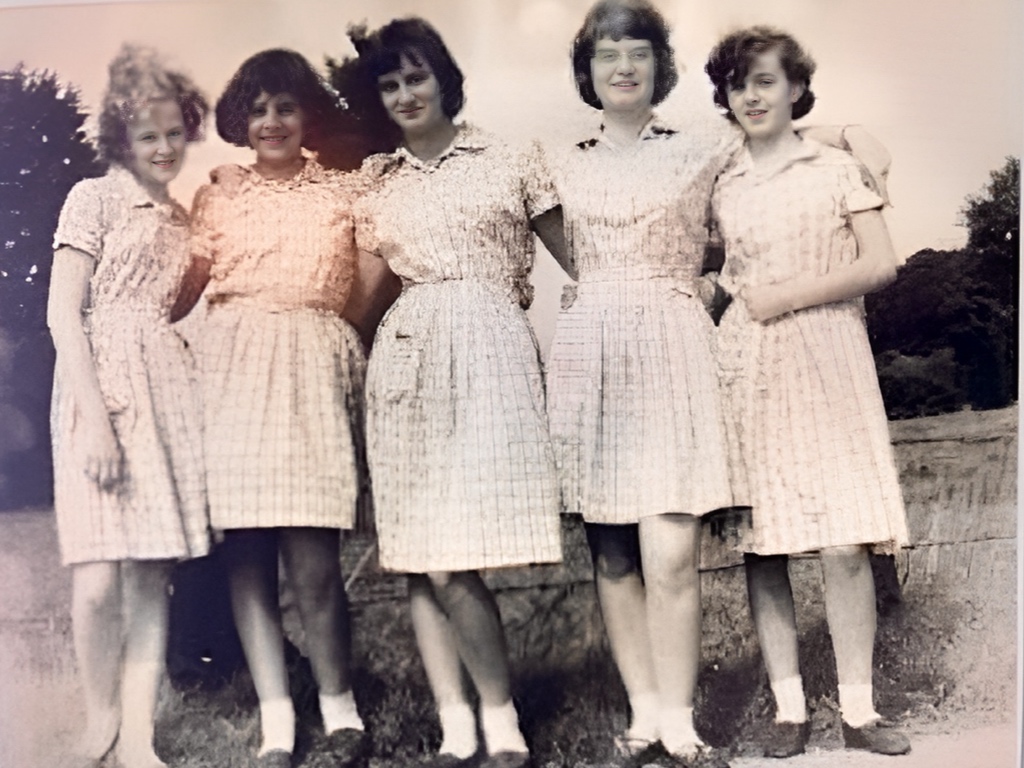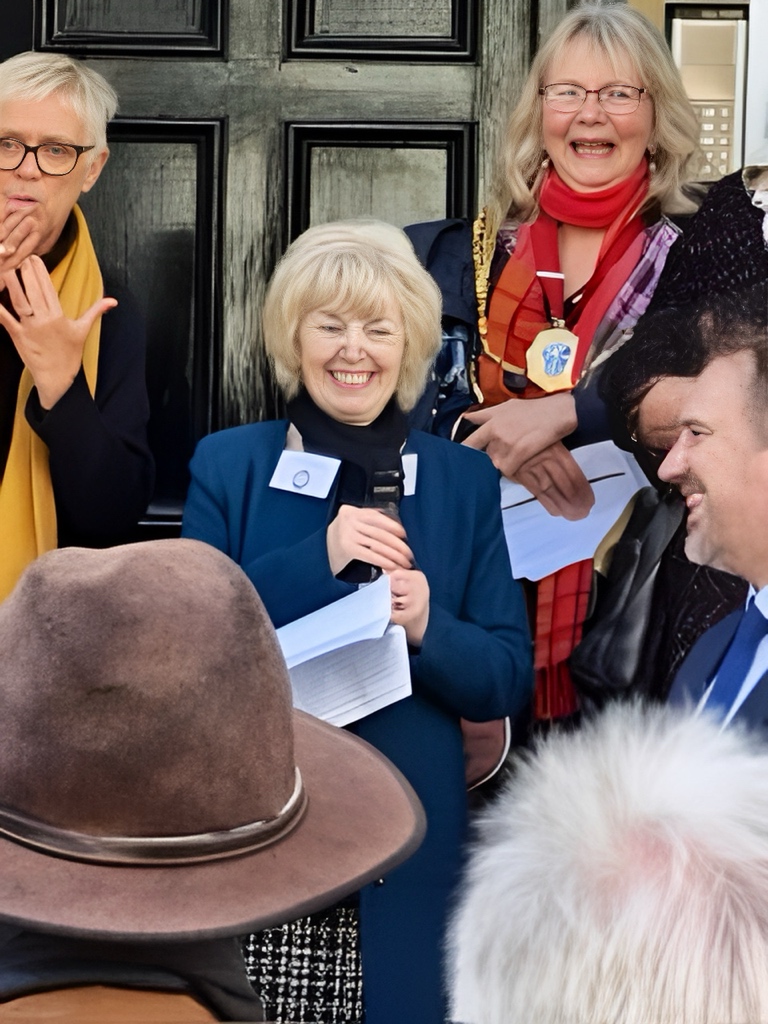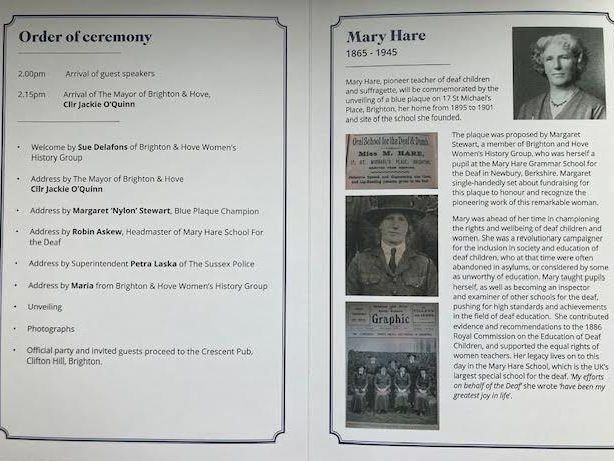Margaret Stewart/Mary Hare
In 2018, Margaret Stewart attended an exhibition in Brighton marking the centenary of women’s suffrage. She was struck by one particular suffragette, who she recognised as the founder of her own school. The Mary Hare Grammar Schoolin Newbury, then as now, is the largest school for the deaf in the UK. ‘There was a portrait of her in the hallway at school’ she remembers. ‘Her eyes seemed to follow you around’. Margaret knew nothing about Mary Hare, or that during World War I there had been a predecessor of the school in Brighton – Margaret’s home town. ‘It jumped out at me’, she says ‘I felt I had to do something.’
Margaret explained how she came to champion a blue plaque for 17 St Michael’s Place Brighton, the site of the school.
I passed the 11 plus and then the entrance exam to attend the Mary Hare Grammar School in Newbury. I remember classes of 10 pupils, boys and girls, sitting in a semi-circle with headphones, speaking into microphones. The School taught lipreading rather than sign language. Some children, with deaf parents, did sign outside school, but this was discouraged. Lipreading did not depend on others knowing the skill, so lead to more independence. We were definitely prepared for the hearing world. We played sports matches against other schools, did the Duke of Edinburgh’s Award Scheme, and had to passcycling tests so we could go and explore. They pushed you into the outside.


When I realised she had lived in Brighton, I was already interested in family history, so started researching Mary Hare. I had noticed that Brighton buses had famous names on them. I put in for one for Mary Hare, and cheekily asked if it could be put on my own route through Patcham – the 5/5A. It took a year or two – there was no notice or confirmation – then one day I came out of line dancing in the middle of the day, jumped on the bus and saw the blurb about her on the inside. I got out and asked the driver to wait while I took a picture of the bus!
Around that time, I met Valerie Mainstone at a Retired Unison coffee morning. She told me about her own campaign, and it made me think about the possibility of a blue plaque. For the next year or so I delved into Mary Hare’s family history. I found there were two houses connected to her in Brighton, which still existed. To find whose permission I needed, I contacted the land registry and contacted the management company but got no response. Finally, I just rang the doorbell. A tenant put me in touch with the managing agent (based in Herefordshire) who was positive, and organised the disclaimer form to get residents’ agreement for a plaque.’
The other main thing I did was fundraising. I had been in touch with the Brighton Blue Plaque Panel, who initially quoted £1,200. I started raising funds through JustGiving – friends, neighbours, school friends, old colleagues – and had got about half when Covid hit. After that, the Panel had raised their quote to £1,500 and were not very encouraging. The fundraising seemed to have stalled, and I lost some momentum. But then my tennis club, the Grasshoppers who had heard the story, made this the raffle’s good cause at their dinner dance. John, my husband, knew, but I had no idea… I gathered up all the cash in my evening bag at the end of the evening – £800!
Valerie invited me to a Brighton Women’s History Group meeting at the Jubilee library, and they had a working group to support Blue Plaques. They put me in touch with the Council, who approved the application and wording of the plaque, and checked conservation status – it wasn’t listed, so it was easier. They also suggested I go direct to the usual stone mason, and order the plaque myself. The building’s façade meant the plaque was a bit smaller than usual, and the mason very kindly gave me a commensurate cost reduction.
I couldn’t have done it without the support of the Brighton Women’s History Group. They did simple things like handling phone calls for me. And they also approached the Mayor to do the unveiling, and agreed a date with her in International Women’s History month – March 2024. Once we had a date – about three months away – everything started rolling. We had an idea for the catering – a pub very near the plaque site, with room outside and in (in case it poured with rain and we had to retire early) – and budgeted for 50 guests with tea and cake after the ceremony. The guest list was mostly personal friends and school friends – many were hearing impaired so we didn’t want a big crowd and lots of dignitaries – it made it more personal. We had to find an interpreter to do the signing, who was fantastic, and hired a sound system with mikes for everyone else. It was on a busy street, but there was a great set of steps up to the front door for the speakers to stand on.

The unveiling ceremony: Margaret, speakers and signer
We had to decide who would give the speeches. As well as the Mayor and me, I invited the Headmaster of Mary Hare School, who turned out to be the son of my old headmaster, which made a nice link. We got in touch with the Head of Brighton Bus Services, who also had responsibility for disability, which was an added connection. She suggested they could ‘lend’ us the Mary Hare bus to be at the ceremony, which was exciting. And Sussex Police sent a very senior female representative, to speak about Mary Hare’s achievements with her voluntary women’s police force. Other people on the invitation list were residents at number 17, and various representatives from hearing charities. If Mary Hare had had any surviving relatives, we would have tracked them down.
As we didn’t want a particularly big crowd, we played it down on social media, but word got out, and we also had some requests for local radio and press interviews, with nice coverage by the Argus and BBC South News. If we had wanted a bigger audience, we could certainly have publicised it more widely, although we were a bit worried about how far the refreshments would stretch…as it was, we had around 70 people in the street, and around 50-60 came to the pub, which felt about right.
There were a few hiccups on the way, like when we noticed last minute typos, but also highs like when the police superintendent accepted our invitation, and when we heard about getting the bus.
We put together a programme for the order of play, and a little bio, to hand out on the day. Logistics were complicated because of the bus, so we got suspended parking for that, and went down to clear it early on the day. It was worth it because the bus gave it all a holiday air. On the day, everything went according to plan, except for a terrific hailstorm at the end which had everyone scampering for cover into the bus which then drove everyone directly round the corner to the pub! It rather washed out the planned photographs…
I’d say ‘enjoy it – it’s something to have achieved – and accept all the help you can get!’
Margaret Stewart, as told to Sue Delafons


The programme for the dedication ceremony